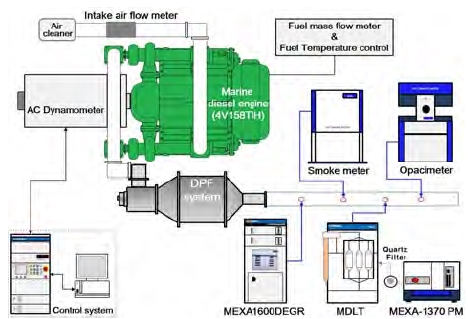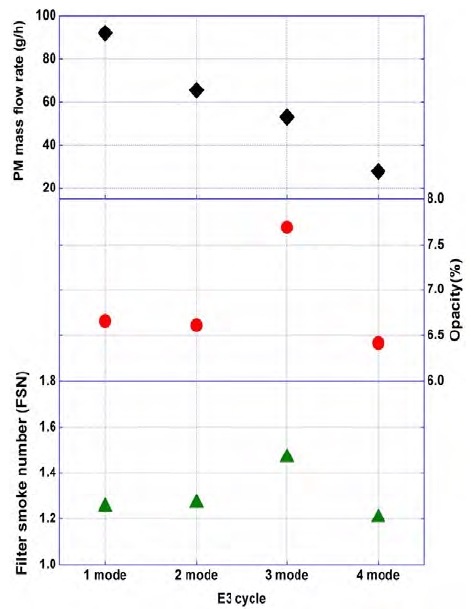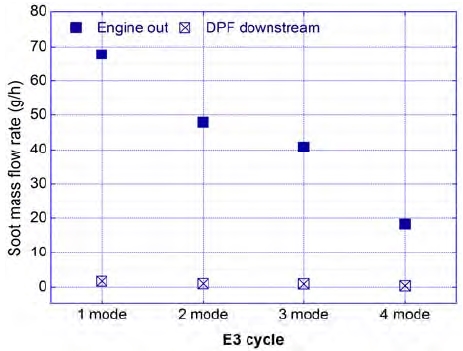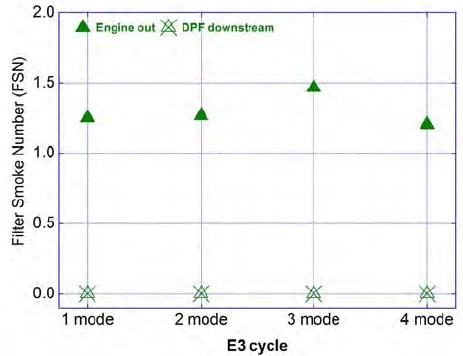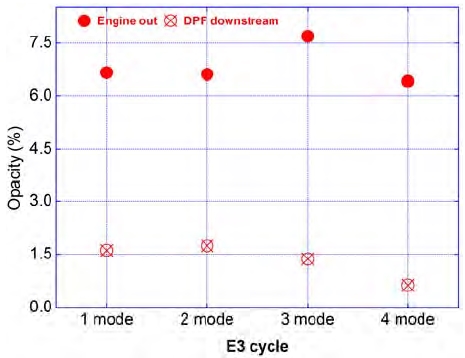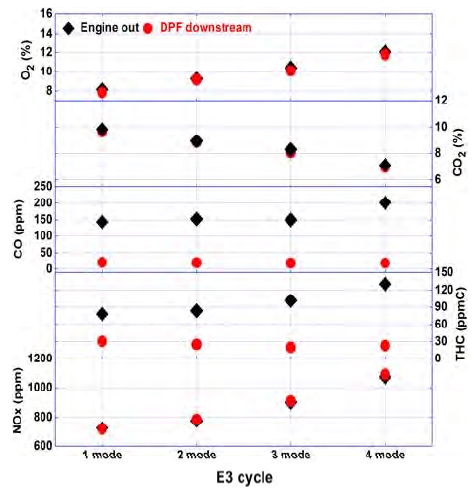
선박용 고속 디젤엔진에 적용한 디젤미립자 필터의 측정방법에 따른 입자상물질 저감효율 비교 연구
Copyright ⓒ The Korean Society of Marine Engineering
This is an Open Access article distributed under the terms of the Creative Commons Attribution Non-Commercial License (http://creativecommons.org/licenses/by-nc/3.0), which permits unrestricted non-commercial use, distribution, and reproduction in any medium, provided the original work is properly cited.
초록
본 연구에서는 입자상물질 저감을 위해 개발한 디젤미립자 필터를 선박용 고속 디젤엔진에 적용하여 측정방법에 따른 저감효율을 비교 분석하였다. 시험에 사용된 엔진은 최고출력 403 kW의 4행정 기계식 선박용 고속 디젤엔진이며, 선박 엔진의 부하와 회전속도 제어를 위해 AC 동력계를 사용하였다. 선박 엔진 시험주기인 E3 cycle의 네 운전조건에서 저감효율을 측정하였으며, 측정방법으로는 입자상물질 및 soot의 저감특성을 살펴보기 위해 분류희석 방법과 광흡수법이 적용된 계측기를 각각 이용하였다. 디젤미립자 필터 적용에 따른 저감효율 측정 결과, 엔진허용 배압을 충족함과 동시에 입자상물질의 경우 76 ~ 91 %, soot(≈블랙카본)은 90 %이상 확인할 수 있었다. 이 결과로부터, 선박용 디젤엔진에서 배출되는 입자상물질 및 soot 저감기술로 디젤미립자 필터 적용 가능성을 확인할 수 있었다. 또한, 측정방법별 저감효율이 상이한 결과로부터 측정방법의 단일화 필요성을 확인할 수 있었다.
Abstract
This study was conducted to compare the particulate removal efficiency of the developed diesel particulate filter using various measurement methods in a high-speed marine diesel engine. A four-stroke mechanical marine diesel engine is used for the test, which has a maximum output of 403 kW and is coupled to an AC dynamometer to control engine speed and load. The test was conducted based on four steady-state engine operating conditions of E3 engine test cycle for the measurement of PM and soot removal efficiency using partial dilution method considered as gravimetric method and filter smoke number method as light absorption method, respectively. As a result of the removal efficiency measurement according to the application of diesel particulate filter, particulate matter was reduced from 76% to 91% and the soot was reduced by more than 90% while meeting the permissible engine back pressure. From these results, the applicability of diesel particulate filter adopted in high-speed marine diesel engines could be confirmed. In addition, based on the result that the particulate removal efficiency varies with different measurement methods, the necessity of unification of these methods could be identified.
Keywords:
Particulate matter, Black carbon, Measurement method, Diesel particulate filter, Marine diesel engine키워드:
입자상물질, 블랙카본, 측정방법, 디젤미립자 필터, 선박 디젤엔진1. 서 론
전세계적으로 환경오염에 대한 심각성이 대두되면서 해양분야에서도 환경오염 방지를 위한 규제가 점차 강화되고 있다. 유럽연합(EU)에서는 이미 내수면 운항 선박에 대하여 stageⅢ 등과 같이 입자상물질의 배출을 제한하고 있으며, 미국환경보호청(EPA)에서도 Tier-3를 통해 규제를 강화하고 있다[1]. 또한 북극항로 개설 및 확대와 해양환경 보호를 위한 규제 강화추세에 따라 국제해사기구(IMO)에서는 선박배출 기후변화물질로 분류되고 있는 블랙카본(Black Carbon)의 규제 도입 논의가 활발히 이루어지고 있다.
해양환경보호위원회(MEPC) 68차 회의에서 규제하고자 하는 블랙카본의 정의가 도출되었다. 즉, 블랙카본은 연료의 연소과정에서 화염 내에서 생성되며 탄소성분의 구분 가능한 물질로 정의되었으며, 이는 입자상물질의 다양한 구성 성분 중, soot으로 간주되고 있다[2][3]. 또한 광흡수성, 내화성, 불용해성의 물리적인 특성을 보유하고, 작은 탄소 입자로 구성된 응집체 형태로 존재하는 물질로 한정지었다[4]. 현재에는 연료의 황 함유량을 규제함으로써 입자상물질을 간접적으로 규제하고 있지만, 선박에서 배출되는 입자상물질 중 블랙카본만을 선택적으로 저감시킬 수 없는 실정이다.
이에 선박엔진에서 배출되는 입자상물질 또는 soot을 저감하기 위한 다양한 기술 개발들이 진행되고 있으며 대표적인 저감기술로 스크러버(Scrubber), DPF(Diesel partic-ulate filter), 전기집진기(Electrostatic precipitator)등이 주목받고 있다[5]-[7]. 스크러버 기술의 경우 세정수를 이용하여 배기가스 내 황산화물을 저감할 수 있는 대표적인 기술로 부가적으로 입자상물질 또는 soot을 저감할 수 있다. 하지만 이 기술은 스크러빙시스템 외에 세정수처리시스템을 추가적으로 장착해야 되는 관계로 소형선박보다는 주로 상대적으로 설치공간이 넓은 대형선박에 적용되고 있다. DPF시스템의 경우 유럽의 내수면・연안 운항 선박에 대한 입자상물질 규제 및 미국환경보호청의 입자상물질 규제 강화에 따라 중소형 선박에 기술적용이 이루어지고 있는 실정이다[8][9].
IMO에서 규제도입 논의 중인 블랙카본을 선행연구에 근거하여[2][3], soot이라 간주하고 본 연구를 수행하였으며, 400 kW급 4행정 선박 주기용 디젤엔진에 개발한 DPF시스템을 장착하여 측정방법별 저감효율 측정 비교 연구를 수행하였다.
2. 실험장치 및 방법
2.1 실험장치
본 연구에서는 어선, 페리, 터그보트 등의 주기관으로 사용되는 4행정 V타입의 최고출력 403 kW인 고속 디젤엔진을 사용하였으며, 엔진의 제원을 Table 1에 나타내었다.
엔진의 속도 및 부하를 조절하기 위하여 AC 동력계(HD460, HORIBA)를 사용하였으며, 가스상 물질 측정을 위해 NTC(NOx Technical Code) 2008에서 요구 사양을 충족하는 배기분석기(MEXA1600DEGR, HORIBA)를 사용하였다.
측정방법별 입자상물질 배출 특성 분석 및 디젤미립자 필터 적용에 따른 저감특성을 분석하기 위해 입자상물질의 배출 질량 유량 측정을 위해 분류희석 방식의 샘플러(MDLT1303TMA, HORIBA)를 사용하였으며, 입자상물질 중 soot 성분비를 구하기 위하여 미립자성분분석기(MEXA1370PM)를 사용하였다. Soot를 측정하기 위해 광흡수법이 적용된 FSN(Filter Smoke Number) 측정용 스모크미터(415SE, AVL)를 사용하였으며[10], 추가적으로 광원 투과율에 따라 배출 농도(%)를 측정하는 오패시티미터(AVL439, AVL)를 사용하였다. 분류희석 방식으로 샘플링한 입자상물질의 배출 질량 유량은 ISO-8178에서 규정하는 항온항습 조건 유지가 가능한 챔버(CHAM-1000K, HORIBA)와 챔버 내에 설치된 고분해능 저울(MAS6.6S-000-DF, Sartorius)을 이용하여 측정하였다.
실험에 사용된 각 분석장치 및 동력계 등의 실험장치 구성 개략도를 아래 Figure 1과 같이 나타내었으며, 시험에 사용된 연료유는 황 함유량이 상대적으로 높은 고유황 경유 HSD(High Sulfur diesel, 0.036 % S)를 사용하였으며, 각 항목별 물성 분석 결과를 위 Table 2에 나타내었다.
디젤미립자 필터 적용에 따른 저감효율 측정을 위해 디젤산화촉매(DOC ; Diesel Oxidation Catalyst)가 포함된 후처리장치를 설치하였다. 후처리장치 내 디젤미립자 필터의 경우 코디어라이트(Cordierite) 재질의 담체를 사용하였으며, 상대적으로 허용배압이 낮은 선박용 엔진의 특성을 고려하여 담체의 입도 및 성분, 기공 사이즈를 변경하였다. 또한, 담체 캐닝 시 불필요한 공간(dead space)에 의한 배압상승을 최소화하기 위해 사각형의 담체를 적용하여 제작하였다. DPF와 DOC 담체의 상세 사항은 Table 3 과 4에 나타내었다.
2.2 실험방법
본 시험에는 NTC 2008의 시험주기 E3 사이클 정속운전 4조건에서 실험을 수행하였으며, 엔진 및 부하조건을 아래 Table 5에 나타내었다.
각 시험 조건별 엔진이 안정화된 이후 가스상 물질과 입자상물질을 측정하였으며, 가스상 물질의 경우 엔진 안정화 이후 60초 동안 받은 측정값을 평균하였다.
입자상물질의 측정방법 별 장비가 다수 설치된 관계로 ISO-8178 규정 준수를 위해 엔진 안정화 이후 측정 장치간의 샘플링 간섭이 없도록 샘플링 및 측정을 순차적으로 하였다.
부분희석터널 방식의 샘플러를 이용한 입자상물질의 질량측정의 경우 70 mm 멤브레인 필터를 사용하여 일정 희석비 조건에서 90초씩 세 번 포집 후 고분해능 정밀 저울을 통해 질량 측정 평균값을 구하였다. 입자상물질 성분분석은 70 mm 석영(Quartz) 필터를 사용하여 포집 후 미립자성분분석기를 통해 구성비를 구하였다. 또한 입자상물질 포집 여지의 흑색화 정도를 나타내는 스모크 미터의 경우 동일조건에서 5번 측정하여 평균값을 구하였으며, 광투과식 매연 측정장치를 이용한 투과율에 따른 입자상물질 농도(Opacity)는 엔진 안정화 이후 60초 동안 측정한 데이터의 평균값을 구하였다.
3. 실험결과
3.1 측정방법별 입자상물질 배출 특성 분석
Figure 2에 나타낸 바와 같이 입자상물질 샘플러를 통해 포집된 입자상물질의 중량을 측정한 결과, 엔진 출력 및 배기유량의 감소에 따라 점차적으로 입자상물질 배출량이 감소하는 경향을 보였다. 하지만, 광투과식 매연 측정장치와 스모크 미터의 측정 결과는 질량 유량 측정 결과와 상이한 경향성을 보이는 것으로 확인 되었다. 이는 측정기의 원리 및 측정단위의 상이성에 기인한 결과로 사료된다.
반면, Figure 3에 나타낸 바와 같이 입자상물질 샘플러에 석영 재질의 필터를 활용하여 포집된 입자상물질을 미립자성분분석기로 운전조건에 따른 성분별(Soot, SOF, Sulfate) 배출 특성을 분석한 결과 입자상물질의 내 Soot의 구성 비율은 65 ~ 76 %로 차지함을 확인하였다. 또한, 성분 분석 결과 입자상물질은 soot 뿐만 아니라 여러 성분으로 구성된 복합체임을 확인할 수 있었다.
3.2 측정방법에 따른 입자상물질 저감 특성 분석
선박엔진에서 배출되는 입자상물질 저감을 위해 개발한 디젤미립자 필터를 적용하여 선박 배출 입자상물질 과 soot의 저감 가능성과 성능을 확인하였다. 또한, 측정방법별 정화효율을 비교 분석하였다.
입자상물질의 질량농도 측정 결과를 Figure 4에 나타내었으며, 엔진 운전조건이 고부하에서 저부하로 변경됨에 따라 배출량이 점차 감소하는 것을 확인 할 수 있었다. 특히, 디젤미립자 필터를 적용 후 엔진부하가 상대적으로 낮은 조건인 3 mode에서 약 91 % 의 높은 저감효율을 보였으나, 엔진 최대출력 조건인 1 mode에서 76 %로 상대적으로 낮은 저감효율을 나타내는 것을 확인할 수 있었다[11][12]. 하지만, 부분희석터널식 샘플러에 석영 필터를 적용하여 입자상물질을 포집하고 미립자성분분석기를 통해 Soot, SOF Sulfate의 성분비를 분석한 결과, 입자상물질은 약 66 % 이상의 soot으로 이루어져 있음을 알 수 있었다. 이에 입자상 물질의 성분비와 질량 농도 값을 곱하여 soot의 배출 질량 유량을 구한 결과, 디젤미립자 필터에 의한 저감효율은 Figure 5에 나타낸 바와 같이 모든 운전 조건에서 90 % 이상을 나타내었다. 이 결과를 바탕으로 디젤미립자 필터의 선박엔진 배출 soot 저감을 위한 후처리장치로써의 적용 가능성을 확인할 수 있었다.
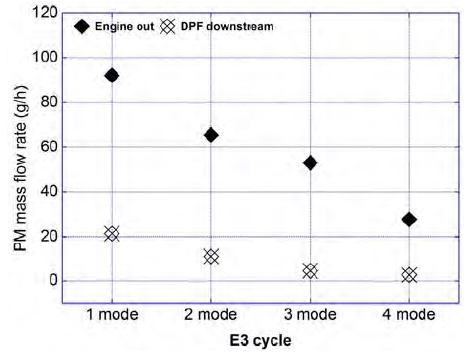
Characteristics of reduction efficiency with a measurement method(gravimetric) under engine operating conditions
스모크 미터를 이용한 FSN 측정을 통해 soot의 저감효율 분석 결과를 Figure 6에 나타내었다. FSN의 경우 모든 운전조건에서 90 % 이상의 저감효율을 보였으며, 이는 앞서 설명한 질량 농도 측정을 통해 계산한 soot의 저감효율 결과와 유사하였다.
오패시미터를 이용하여 soot의 저감 특성을 분석한 결과를 Figure 7에 나타내었다. 오패시티를 이용한 Engine-out 입자상물질 배출량 경향과 디젤미립자 필터 적용 이후 배출량 경향이 상이함을 확인 할 수 있었다. 저감효율 측정결과 엔진 부하조건 낮고 연료소모량 적은 4 mode에서 90 %의 저감효율 나타냈으며, 2 mode에서 73 %의 가장 낮은 저감효율을 보였다. 오패시미터를 이용한 엔진 운전조건별 저감효율 측정값을 평균한 결과 80 %의 저감효율을 보였으며, 앞서 설명한 질량측정법으로 구한 저감효율 보다 상대적으로 낮은 저감효율을 나타내었다.
3.3 디젤미립자 필터 적용에 따른 가스상 배출물 특성 분석
디젤미립자 필터 적용 전/후의 가스상 배출물 측정 비교결과를 Figure 8에 나타내었다. NOx, O2 및 CO2의 경우, 디젤미립자 필터 적용 전/후 거의 유사한 측정값을 나타내었다. 반면, THC와 CO의 배출물 측정 결과, 디젤미립자 필터 적용 후 70 % 이상의 저감효율을 보였으며, 이는 선행연구결과와 유사하였다[13][14]. 이는 디젤미립자 필터 내에 설치된 디젤산화촉매(DOC)의 화학적 반응(산화)에 기인하여 저감된 것으로 사료된다.
4. 결 론
선박용 고속디젤엔진에서 배출되는 입자상물질과 soot을 측정방법이 상이한 장치를 활용하여 측정하였을 때 측정방법에 따라 배출특성에 차이가 있음을 확인할 수 있었다. 특히, 디젤미립자 필터 적용에 따른 입자상물질 측정방법별 저감효율 측정 결과, 분류희석 방법으로 측정된 입자상물질 저감효율은 운전조건에 따라 최대 91 %와 최저 76 %로 엔진운전조건에 따라 상이하게 나타났다. 반면, 입자상물질의 성분비와 질량농도를 곱으로 구한 soot(블랙카본)의 저감효율은 90 % 이상을 나타냈다. 또한, 광흡수법이 적용된 스모크미터로 soot의 저감효율을 측정한 결과, 모든 운전 조건에서 90 % 이상의 저감효율을 나타냈다. 추가적으로 수행한 오패시미터를 이용한 저감효율의 측정결과, 최대 80 %로 나타났다.
결론적으로, 소형선박 배출 입자상물질 및 soot을 저감하기 위한 대응 기술로 디젤미립자 필터의 적용 가능성을 확인할 수 있었다. 다만, 측정방법별로 측정 대상물질이 상이하기 때문에 측정한 저감효율 또한 달라질 수 있기 때문에 선박엔진에 적용 가능한 입자상물질 또는 soot의 저감시스템 개발 및 신뢰성 있는 평가결과 도출을 위해서는 측정방법의 단일화가 필요하다고 사료된다.
Acknowledgments
본 연구는 해양수산부의 해양안전 및 해양교통시설개발사업의 “선박배출 대기오염원(PM, BC) 기후변화 영향평가 및 저감기술 개발” 과제의 지원으로 수행되었으며, 이에 감사드립니다.
References
- Dieselnet, https://dieselnet.com/standards/eu/nonroad.php Accessed August 22, 2016.
-
P. Fermo, A. Piazzalunga, R. Vecchi, G. Valli, and M. Ceriani, “A TGA/FT-IR study for measuring OC and EC in aerosol samples”, Atmospheric Chemistry and Physics, 6(1), p255-266, (2006).
[https://doi.org/10.5194/acp-6-255-2006]

-
O. Popovicheva, D. Baumgardner, R. Subramanian, G. Kok, R. Cary, E. Vlasenko, and E. Kireeva, “Tailored graphitized soot as reference material for EC/OC measurement validation”, Atmospheric Measurement Techniques, 4(5), p923-932, (2011).
[https://doi.org/10.5194/amt-4-923-2011]

- MEPC 68th session 2015, Report of the Marine Environment Protection Committee on It’s Sixty-eighth Session, International Maritime Organization.
- H. Kawakami, A. Zukeran, K. Yasumoto, M. Kuboshima, Y. Ehara, and T. Yamamoto, “Diesel exhaust particle reduction using electrostatic precipitator”, International Journal of Plasma Environmental Science & Technology, 5(2), p179-183, (2011).
- I. M. Ariana, O. Nishida, H. Fujita, W. Harano, and M. Fujio, “Removal of marine diesel particulate matter by electrostatic precipitator, ICESP X—Australia, paper 4A2 (2006).
- K. W. Chun, K. W. Lee, M. E. Kim, and J. H. Choi, “Reduction technology trends of particulate matters from ship, Korea Society of Marine Engineering fall Conference, p145-147, (2010), (in Korean).
- J. P. Hansen, J. Kaltoft, F. Bak, J. Gortz, M. Pedersen, and C. Underwood, Reduction of SO2, NOx and Particulate Matter from Ships with Diesel Engines, Environmental Project, (1510), p38-64, (2013).
-
K. Johansen, “Multi-catalytic soot filtration in automotive and marine applications”, Catalysis today, 258, p2-10, (2015).
[https://doi.org/10.1016/j.cattod.2015.06.001]

- CIMAC Working Group (Exhaust Emissions Control), (2012), Background Information on Black Carbon Emissions from Large Marine and Stationary Diesel Engines - Definition, Measurement Method, Emission Factors and Abatement Technologies, The International Council on Combustion Engines.
- S. H. Oh, H. K. Kim, and B. H. Yoo, “An experimental study on the emission characteristics of diesel particulate matter, Korea Society of Marine Engineering fall Conference, p93-94, (2006), (in Korean).
-
H. M. Lee, and R. E. Park, “Exhaust emission characteristics from heavy-duty diesel engine applicable to prime propulsion engine for marine vessels”, Journal of the Korean Society of Marine Engineering, 36(4), p484-489, (2012), (in Korean).
[https://doi.org/10.5916/jkosme.2012.36.4.484]

-
T. Tang, J. Zhang, D. Cao, S. Shuai, and Y. Zhao, “Experimental study on filtration and continuous regeneration of a particulate filter system for heavy-duty diesel engines”, Journal of Environmental Sciences, 26(12), p2434-2439, (2014).
[https://doi.org/10.1016/j.jes.2014.04.004]

- K. H. Kim, G. J. Ahn, K. W. Kang, S. W. Lee, D. S. Eon, and T. Y. Lee, “A study of unregulated emission reduction characteristics by diesel oxidation catalyst(DOC) for ligth-duty diesel engine”, Transaction of the Korean Society of Automotive Engineers, 14(2), p145-150, (2006), (in Korean).


